|
Marines F-14A Tomcat
"What If"
Weapons and Markings
by Andrew Desautels
|
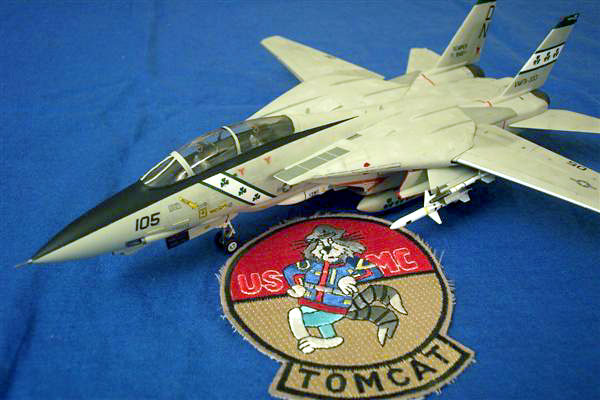 |
|
F-14A Tomcat |

HyperScale is proudly sponsored by
Squadron
It was July 1975, exactly one year before the United
States of America was to celebrate its 200th birthday. After planning and
training for the new aircraft, the United States Marine Corps was told it
would not be receiving its nation's newest superfighter, the F-14
Tomcat.
Some USMC aircrews had already been involved in the
F-14 training syllabus in preparation for the first operational Marines
Tomcat squadron, but now were told to stick with F-4 Phantoms retired from
the Navy for the forseeable future, which would finally end with the
introduction of the F/A-18 Hornet. Yet for years afterward some have
dreamed of what an F-14 Tomcat in USMC markings might look like.
Eventually I joined their ranks.
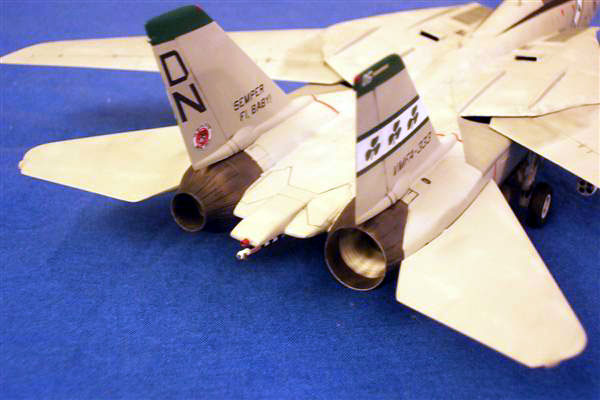
I'm not completely certain how this project began. It may have its roots
in the day I managed to purchase a surplus USMC Tomcat patch intended to
have been worn by elite aerial warriors which never materialized. It may
have been unavoidable as I wondered what to do with a handful of VMFA-333
decals left over from another modeling project, combined with my long love
of the Tomcat. In any case, once it began, there was no stopping it except
for food, work and sleep.
Wanting a fairly quick and easy build, I selected an
old favorite of mine, the 1/72 Hasegawa "Old-Tool" F-14A.
Normally I include a highly detailed cockpit with an
open canopy in my aircraft, but I kept this one minimal since I thought
the closed canopy would better display the sleekness of the stylized
antiglare panel extending from the pitot probe to well past the canopy.
The beautifully clear canopy is enough to nicely display the True Details
aftermarket seats with ejection handles made from fine copper wire
salvaged from an abandoned lamp cord.
Even as construction began, advanced planning had
already been done on the weapons fit. Although the Marines who had been
involved in the F-14 syllabus had no different training from their Navy
counterparts, it seemed to me that the addition of air-to-ground munitions
would have been an unavoidable eventuality, since the primary task of USMC
air power is the support of their ground troops. It made sense to me that
the wing glove pylons would have had specialized adaptors for carrying
ordnance other than the usual air-to-air missiles, so I set about creating
a fictional wing glove pylon, redesigned below the sidewinder rail.
Some of the weapons fit was influenced by the planned timeline of the
markings. For some strange reason, in my mind I had worked out a projected
Tomcat scheme for USMC squadron VMFA-333 "Fighting Shamrocks" in an
overall gull gray scheme (strange since I've never liked the overall gull
gray scheme on any Tomcat), with a markings style consistent with USN
markings of the very early 1980's. Because of this, I elected not to use
the more recent bomb pallets used by Tomcats (aka 'Bombcats') in the
1990's and beyond. I ended up scratch building the original modified
phoenix missile pallets which were intended to carry 500-lb bombs, tested
on the early Tomcats in the 1970's. Although the pallets in and of
themselves could each carry four such bombs, the rear pallets had limited
space because of the narrowing of space between the engine nacelles, and
so only carried 3 each (total 14 bombs if all 4 pallets were used).
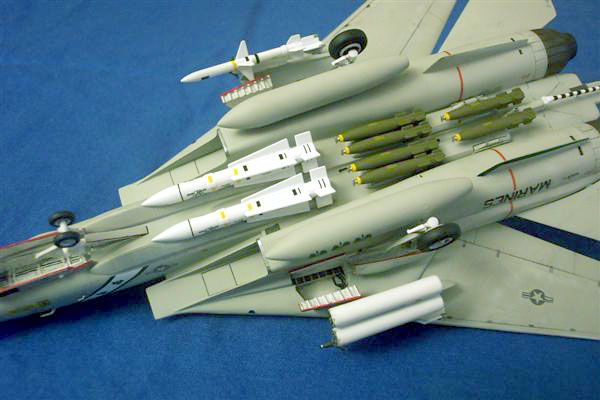
From the very start I had intended the aircraft to carry a pair of AIM-54
Phoenix missiles on the forward pallets; I wanted to show that the Marines
would not have received Tomcats without the Phoenix capability, the main
reason for the Tomcat's very existence. Two AIM-9L Sidewinders were also
added, which were from the Hasegawa 1/72 weapons set although I
scratchbuilt the forward canards.
Finally the air-to-ground weapons fit for the wing glove pylons was
selected: a pair of LAU-10 rocket launchers mounted on a TER on the
starboard side, and an AGM-45 Shrike antiradiation missile on a
scratchbuilt launch rail on the port.
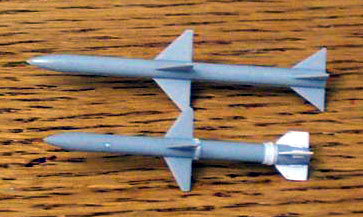 The
Shrike posed a bit of concern since I didn't have one in 1/72, and wasn't
crazy about spending $6-8 for a whole weapons set for only one piece out
of it. So, I made one out of a Sparrow missile from the F-14 kit. I
already had a Shrike in 1/48, and putting it side-by-side with a 1/48
Sparrow, I was able to accurately assess the changes to make in 1/72
scale. This ended up being far easier than I had planned, and the result
exceeded my hopes. The
Shrike posed a bit of concern since I didn't have one in 1/72, and wasn't
crazy about spending $6-8 for a whole weapons set for only one piece out
of it. So, I made one out of a Sparrow missile from the F-14 kit. I
already had a Shrike in 1/48, and putting it side-by-side with a 1/48
Sparrow, I was able to accurately assess the changes to make in 1/72
scale. This ended up being far easier than I had planned, and the result
exceeded my hopes.
The rocket pods were equipped with olive-drab painted rocket tips,
indicating high-explosive rounds, which I settled on instead of
black-colored armor-piercing rounds, although I still wonder if I should
have had one pod of each type.
The markings for the Tomcat were put together from a
wide variety of decal sources, including Superscale, RepliScale,
ScaleMaster and CAMdecal aftermarket sheets, plus Hasegawa and Italeri kit
decals. The markings took 3 1/2 days of intense (read 'psychotic')
nitpicking. The white and green bands on the tail and forward fuselage
were airbrushed to provide a background for the actual shamrocks markings.
The "DN" tailcode on the insides of the tails were most frustrating, made
from cutting strips of black decal, making block letters out of the strips
on the tail while angling them to fit the sleek lines of the rudder, and
trimming off excess with a fresh blade.
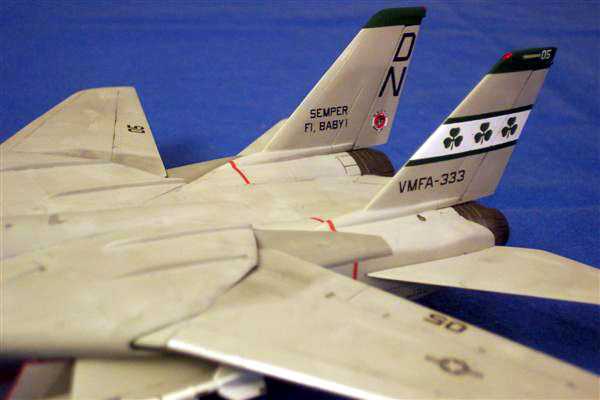
The final touch to the markings was originally to have put "Semper Fi" on
the upper surface of the wing gloves, inspired by the photo on the last
page of Squadron's "F-14 Tomcat Walkaround" showing the VF-32 Tomcat with
the legend "GO NAVY BEAT ARMY" on the upper surfaces. Eventually I thought
of moving it to the insides of the tail, and then in the middle of the
night it hit me that if it was a Marine Corps Tomcat, the legend "Semper
Fi, Baby!" should have been the obvious choice from the start. And so I
spent an evening applying this slogan one letter at a time to each tail,
making an exclamation point from an "I" and a pair of commas from a "Q"
which I would probably not ever need (knock on wood).
The end result is not merely a Tomcat in USMC
warpaint, but a Tomcat equipped with a wide variety of ordnance with which
to achieve total battlefield supremacy, from long-range Phoenix missiles
to keep enemy aircraft away from the battle zone, short-range Sidewinders
for any that make it past the Phoenix envelope, a Shrike missile to
disable enemy radar installations, rocket pods and 500-lb Snakeye bombs
for assorted ground targets including troop positions and vehicles, and of
course the internal M-61 Vulcan cannon for use against either air or
ground targets.
And so: Anytime Baby, and Semper Fi, Baby!
Click the
thumbnails below to view larger images:
Model, Images and Text Copyright © 2002
by Andrew Desautels
Page Created 11 May, 2003
Last Updated
17 March, 2004
Back to
HyperScale Main Page |
Home |
What's New |
Features |
Gallery |
Reviews |
Reference |
Forum |
Search